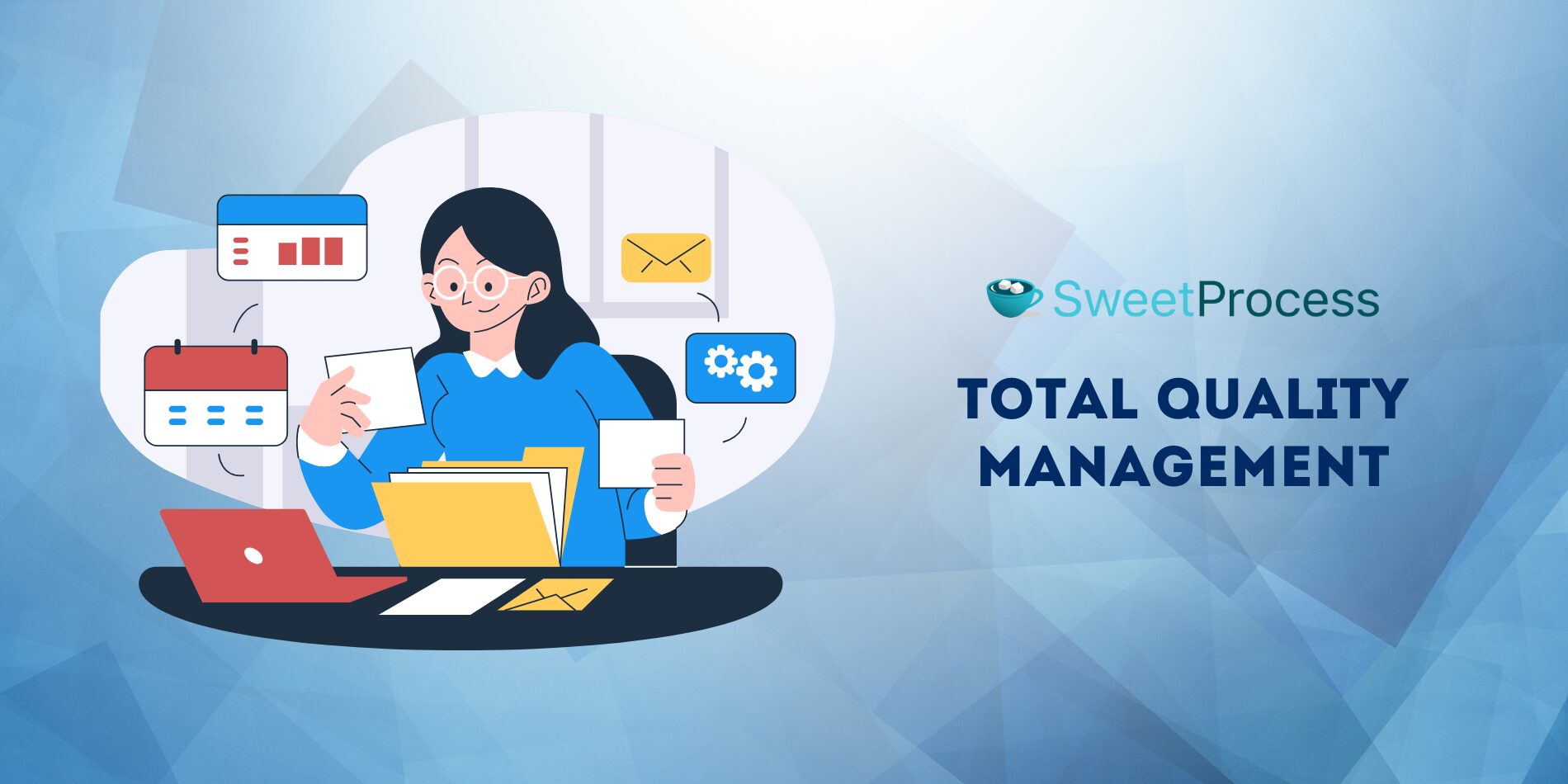Last Updated on March 2, 2025 by Owen McGab Enaohwo
In the 1950s, Toyota factory workers could pull a cord to stop the entire production line if they spotted a defect. Stopping an entire factory for one issue might have seemed crazy at the time. However, this simple practice, known as the Andon Cord, revolutionized manufacturing quality worldwide and propelled Toyota into decades of unmatched quality and industry leadership.
In practice, Total Quality Management (TQM) means building quality into every aspect of your work, from product design to customer service. Today, companies like Apple, Amazon, and even your local coffee shop use total quality management principles to deliver consistently excellent products and services.
This article will discuss how TQM works, its benefits, and, most importantly, how to implement it in your organization.
Sign up for a free trial of SweetProcess to improve your quality management process. Access all features for 14 days—no credit card required.
What We Cover In This Guide:
What Is Total Quality Management?
Benefits of Total Quality Management
What Are the Core Principles of Total Quality Management?
Using SweetProcess to Enhance Total Quality Management
How to Implement Total Quality Management in Your Organization
Total Quality Management Examples to Inspire Your Team
Tools for Effective Total Quality Management (TQM) Practices
Improve Your Company’s TQM Practices With SweetProcess
What Is Total Quality Management?
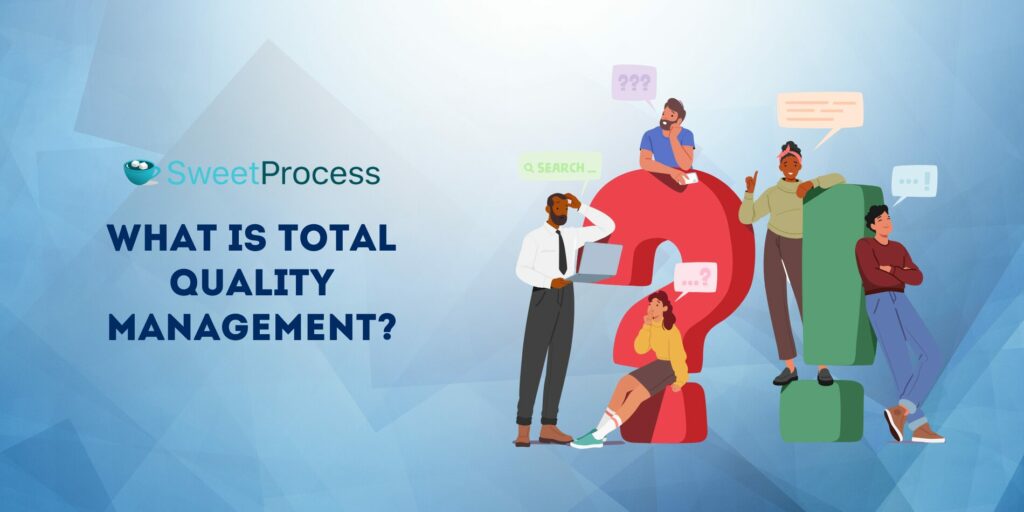
Total Quality Management is a philosophy that unites everyone in your organization around a shared commitment to delivering quality in everything they do.
Think of total quality management as a company-wide game of “getting it right the first time,” with everyone—from the CEO to the newest hire—focused on maintaining high-quality standards at every step.
For example, whenever you order a Starbucks coffee, you expect it to taste the same whether you’re in New York or Tokyo. That consistency doesn’t happen by accident. It’s TQM in action: carefully designed processes, trained baristas, quality ingredients, and regular checks all working together.
Benefits of Total Quality Management
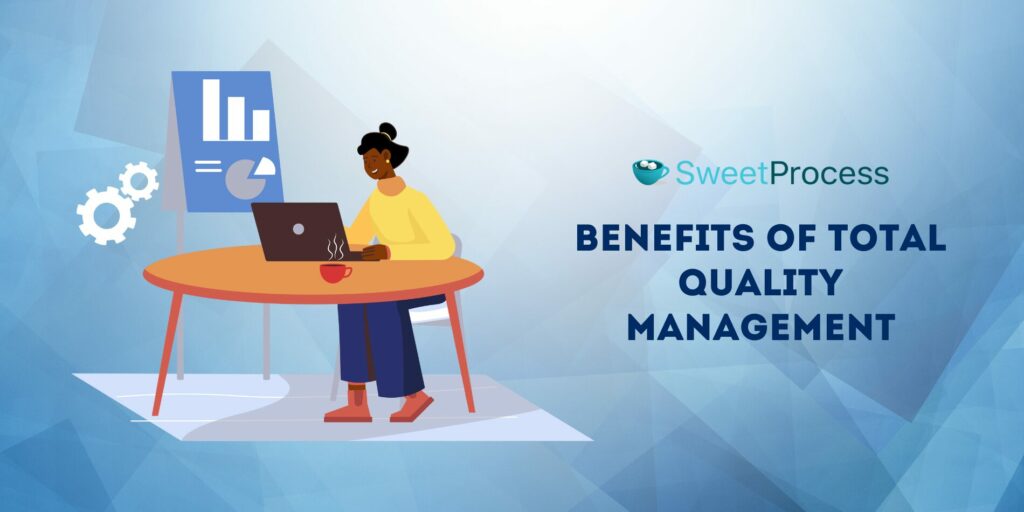
Stronger Competitive Position
TQM strengthens a company’s position by aligning efforts to deliver consistent quality, which sets the business apart from its competitors.
For example, when FedEx implemented TQM, they created their famous “when it absolutely, positively has to be there overnight” campaign. This guarantee and commitment to quality turned them into the go-to choice for urgent deliveries.
Enhanced Market Image
Adopting TQM aligns a company’s efforts with frameworks like ISO standards and Six Sigma practices, which support achieving and maintaining high-quality outcomes. Plus, implementing these frameworks reassure clients and customers of the organization’s commitment to excellence.
A great example is Apple. Their obsession with quality, from product design to packaging to store experience, has created a brand image that lets them charge premium prices. People trust that an Apple product will just work.
Reducing Costs and Increasing Efficiency
Total quality management ensures that every aspect of the operation contributes to value creation by minimizing defects, improving resource allocation, or organizing workflows.
The result is improved productivity and substantial cost savings from fewer reworks, less downtime, and better inventory management.
Improved Focus on Customer Satisfaction
TQM creates a culture where customer feedback drives improvements. From resolving product issues quickly to anticipating customer needs through data insights, total quality management shifts the focus from just meeting expectations to exceeding them.
A great example is Zappos, which makes returning shoes incredibly easy. Customers can return eligible items for a full refund within 365 days of purchase—a whole year! This means someone with the wrong shoe size can easily exchange or refund their purchase without feeling pressured to do so at an inconvenient time.
Improved Employee Morale
When employees have clear processes and the authority to make quality-related decisions, job satisfaction soars. TQM fosters a sense of ownership by encouraging workers to contribute ideas and take responsibility for outcomes.
Increased Job Security
Organizations implementing TQM have the potential to perform better in volatile markets because they consistently deliver high-quality products and maintain strong customer relationships.
This stability benefits employees by providing a sense of security and fostering loyalty, as they view their roles as integral to the company’s ongoing success.
Higher Productivity
TQM incorporates continuous improvement methods, such as lean or Kaizen, to optimize resources. Also, when everyone knows exactly what “good” looks like and how to achieve it, problems are addressed at their root, and work flows smoothly.
Higher productivity allows businesses to scale operations, meet customer demands promptly, and maintain profitability without overburdening their workforce.
What Are the Core Principles of Total Quality Management?

Customer Focus
Customer focus means making decisions based on what your customers want—not what you think they want.
When Netflix shifted from DVD rentals to streaming, they were responding to clear customer behavior patterns showing that people wanted instant access to content. Today, they continue this customer focus by using viewing data to inform content creation decisions.
Total Employee Commitment
Total employee commitment means everyone understands their role in quality management and actively participates in improvement efforts.
When workers are empowered, trained, and aligned with the organization’s quality goals, they contribute innovative ideas and take ownership of outcomes. A culture of trust and collaboration transforms the workforce into a unified team striving for excellence.
Adherence to Processes
This principle emphasizes creating, documenting, and following standardized processes that consistently deliver quality results. The goal isn’t to create bureaucracy but to establish a reliable foundation for quality work and quality assurance.
Adhering to clearly defined processes also enables easier monitoring and allows for systematic improvements over time, ensuring quality assurance and predictable results.
Promote an Integrated System
An integrated system connects all organizational processes to work together harmoniously. This means breaking down silos and ensuring different departments collaborate effectively.
Take Amazon’s system, for example. Its warehouse operations integrate seamlessly with its website, delivery networks, and customer service. When you click “buy,” this integration ensures your inventory is accurately counted, picked efficiently, appropriately shipped, and tracked in real time.
Strategic and Systematic Approach
Quality management should align with the organization’s strategic goals. A systematic management approach ensures that your initiatives are planned, executed precisely, and monitored for effectiveness. This principle ensures that quality improvements contribute directly to the company’s long-term vision.
Quality improvement requires a planned, long-term approach aligned with organizational goals. This means you should have a clear quality vision and concrete plans to achieve it.
Continuous Improvement
Often called Kaizen in quality management circles, continuous improvement means that you are never satisfied with the status quo. It’s about making small, incremental improvements every day.
Adopting this mindset encourages innovation, adaptability, and resilience. Businesses committed to continuous improvement remain agile and better equipped to address challenges in a competitive environment.
Fact-Based Decisions
Gut feelings and assumptions have no place in TQM. Instead, decisions are based on data and analytics.
Google’s approach to website optimization is proof of this. They don’t guess what design changes might work better—instead, they run thousands of A/B tests annually, collecting data on user behavior before making decisions about every change.
Communication
From top management to frontline employees, communication is the thread that ties the entire system together.
Pixar’s Brain Trust meetings are an excellent example of great quality-focused communication. These sessions bring together diverse team members to provide honest feedback on films in development. Everyone gets to speak freely, with a collective focus on solving problems and improving quality.
Using SweetProcess to Enhance Total Quality Management
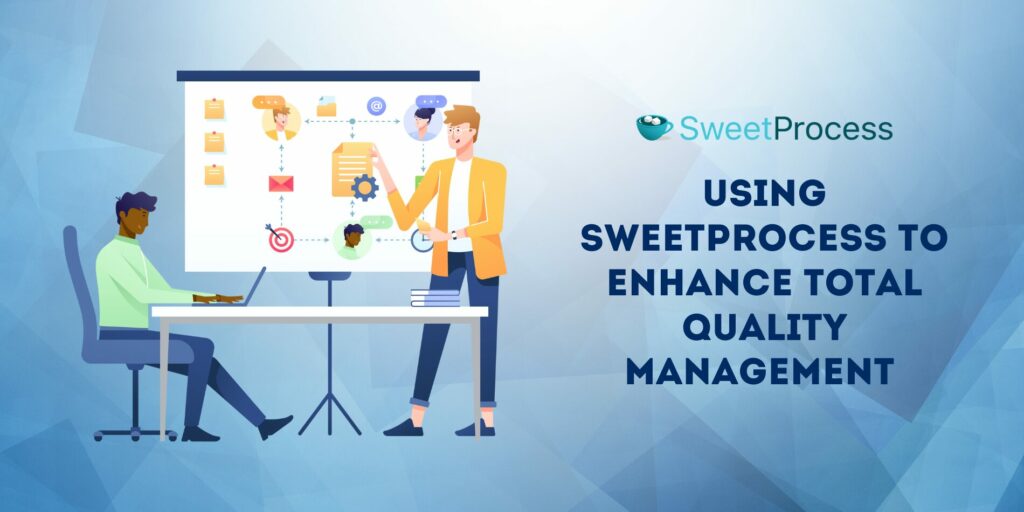
Create Processes, Policies, and Procedures with SweetProcess
Creating processes, policies, or procedures is the same.
Go to your main dashboard and click on what you want to document. Let’s say it’s a policy.
Go to the “More” tab and select “Policies.”

Click on “Create Policy” to continue.

Write a title for the document.

Tap on the “Click here to edit policy content” to add the description, and click on “Approve” to save it.

Build a Quiz to Assess Your Team’s Grasp of Company Policies, Processes, and Procedures
Scroll to the “More” tab to locate the “Quizzes” button.

Then click on “Create Quiz.”

Give the quiz a name.

Decide if you want it to have a single or multiple-choice answer.

If you choose the open-ended answer option, here’s how it will look once you customize it to your taste.
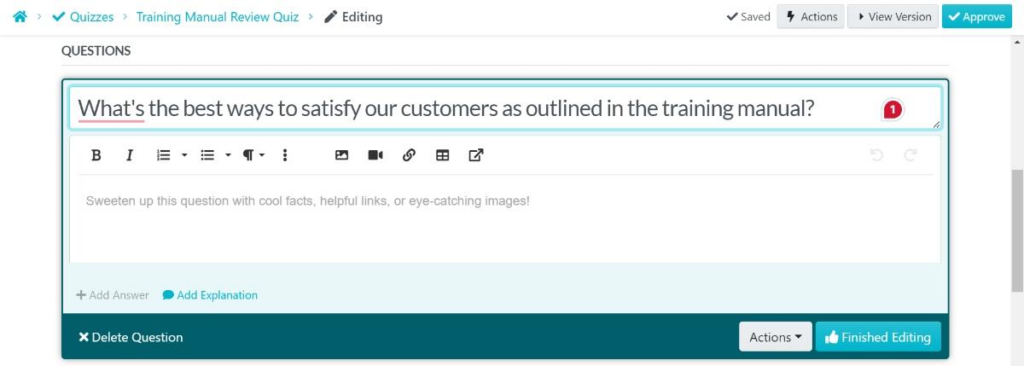
After adding a question, click on “Add Question” to add as many as you want.

Turn Procedures and Processes Into Actionable Tasks
To set this up, go to your “Tasks” tab and click on “Assign Task.”

Pick a document from one of your procedures or processes and click “Next.”

Then add a team member to handle the task.
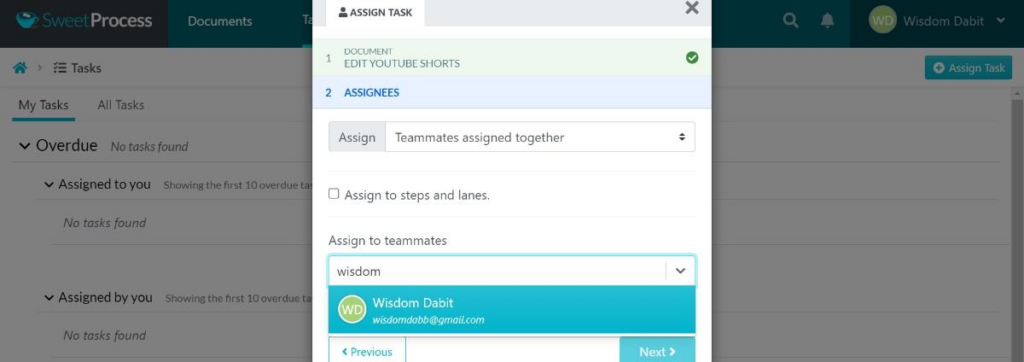
Set a due date for the project completion and save.

Manage Procedures, Processes, and Policies
Checking or browsing through your procedures, processes, and policies is easy.
Simply visit the SweetProcess main menu to locate them.

You can also use the file search box to type and instantly locate any file in seconds.

You can also filter your search results by team, tags, or relevance if you are not okay with the results that pop up.
Set up Teams to Reflect Your Company Culture
You can also create teams within your organization to reflect your company’s culture in SweetProcess and guide your employees in adhering to your processes and procedures.
Go to “Teams” on your dashboard.

Click on “Create Team.”

After that, write the team’s name and more details like the description, and click on “Create Team” to save.

All of these SweetProcess features have been helpful to a lot of managers and small business owners in total quality management.
A good example is the general manager and COO of New Media Retailer, Francesca Halberg, who struggled with keeping up with trends and communicating with her employees. After spending several hours creating business procedures, the information would become obsolete in about a week, making their entire efforts a total waste.
In her words:
“As the general manager, I was definitely spending a significant amount of my time answering a lot of employee questions…. We didn’t have a clear communication or a central communication hub where we could really house a lot of these frequently asked questions from our staff. I personally was spending a lot of my time individually training.”
After getting tired of the constant communication disconnect between employees, she and her team opted for a workflow management software solution.
Now the question is, did signing up for SweetProcess turn out to be a good or bad decision?
Well, don’t take our word for it. Keep reading for more of Francesca and New Media Retailer’s experience:
The company already knew there was a problem with its employee onboarding training. Still, it could not pinpoint it until a former employee experienced some pain points during his onboarding training and voiced his concerns.
It made them realize they needed to get a system in place to tackle their operational challenges. They embarked on a search for a solution and found SweetProcess.
“We had a really clear picture of exactly what was going on and what everybody was doing that we never really had before,” Francesca says. “Jumping back to a previous solution, with Google Docs, although we were able to lay things out like one, two, three, four, five, we never knew who was utilizing it, where they were in it, and how they could really make it work for themselves. Fast forward to SweetProcess, and you can check off exactly where you are at when creating projects for specific customers. It’s really fine-tuned the process for us in such a large way, which has just been super valuable for our organization as a whole.”
Similarly, Stone & Wood turned around its business performance using SweetProcess to enhance the company’s total quality management.
Due to inadequate systems to document processes, Tom Parker, the quality assurance and sensory coordinator at Stone & Wood, also struggled to maintain quality standards in their company, but since he tried SweetProcess, they’ve solved their operational inadequacies, and their team productivity has improved.
“It gets a lot of use for onboarding new staff,” Tom says of SweetProcess. “We often get casual labor for a single day’s work. To do that, they have to go through safety induction, quality induction, and various other little documents, so we’ve actually put them all into SweetProcess. We can assign that process as a task to someone, and they can read through it at their own pace, tick it off, and then the manager can come back and see that they have done all of that. It’s working well for us in that regard.”
How to Implement Total Quality Management in Your Organization
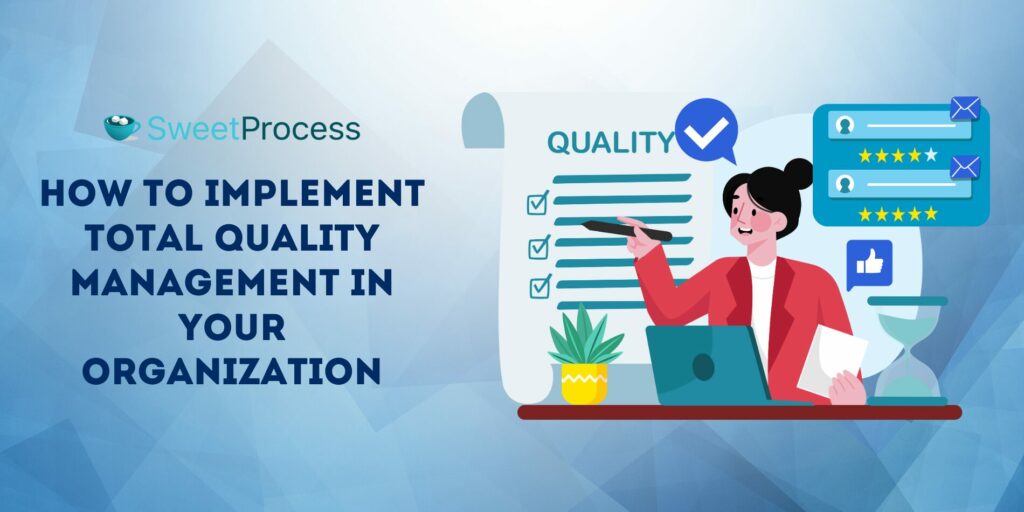
Management Commitment
Quality initiatives must start at the top. Leadership needs to demonstrate their commitment through actions. This means allocating resources, participating in quality initiatives, and modeling quality-focused behavior. Management’s dedication sets the tone for the entire organization.
The transformation of Ford Motor Company in the 1980s perfectly shows this. When CEO Donald Petersen made quality his top priority, he reorganized the entire company around quality principles, personally attended quality training sessions, and tied executive compensation to quality metrics.
Establishment of a Quality Policy
Develop a quality policy that serves as a roadmap for the organization’s objectives and values. This policy should articulate your commitment to delivering excellence and align with the needs of your customers and stakeholders.
Ritz-Carlton’s Gold Standards exemplify an effective quality policy. Their credo, “Ladies and gentlemen serving ladies and gentlemen,” is supported by specific service standards, employee empowerment guidelines, and daily quality practices.
Training and Education of Employees at All Levels
Quality management requires a systematic approach to training. Every employee must understand quality principles, measurement methods, and problem-solving techniques.
Implementing this approach was how Motorola University successfully transformed its organization. They created comprehensive programs ranging from basic quality awareness for new hires to advanced statistical analysis for engineers. This investment in training helped them achieve breakthrough improvements in product quality.
Establish Cross-Functional Teams
Cross-functional teams enhance communication, promote diverse perspectives, and drive innovative solutions to quality challenges.
For example, Apple utilized cross-functional teams while developing the first iPhone. Hardware, software, and design engineers collaborated closely, regularly presenting their work to managers and executives to gather feedback and refine the product.
Yes, there were frustrations and many miscommunications; however, this collaborative approach was instrumental in preventing quality issues and significantly contributed to the iPhone’s success.
Quality Improvement Projects
Improvement projects provide focused opportunities to solve specific quality problems or achieve particular quality goals. These projects should follow a structured methodology and involve people closest to the process.
3 M’s famous Post-it Notes emerged from a quality improvement project. When initial adhesive formulas weren’t working, the team kept experimenting and testing until they found the perfect balance.
Implement Process Controls
Process controls monitor key variables to identify and address issues before they escalate into problems. Introduce tools like control charts and process audits to ensure consistency and reduce variability.
Think about how Coca-Cola maintains consistent taste worldwide. Their statistical process control ensures every bottle meets its quality standards, whether it’s produced in Atlanta or Nigeria.
Maintain Good Partnerships With Suppliers
Quality starts with inputs. Collaborating closely with suppliers to ensure they meet your quality standards and share your commitment to continuous improvement is best. Taking proactive steps to strengthen these relationships can lead to long-term benefits for both parties.
Toyota’s approach to supplier relationships, for example, goes beyond evaluating suppliers on price alone to working closely with them and sharing knowledge and resources to improve the quality of materials.
Continuous Monitoring and Measurement
You can’t improve what you don’t measure. Effective TQM implementation requires ongoing monitoring of key quality indicators and customer feedback.
One close example is Amazon’s customer satisfaction monitoring system. They track a wide range of metrics, from delivery times and customer reviews to website performance. Analyzing this data allows them to drive continuous improvements in service quality.
Employee Involvement and Empowerment
Give employees the authority to make quality-related decisions. One way of doing this is by creating channels for suggesting improvements and reporting quality issues.
Recognize and reward high-quality contributions to motivate employees and encourage more participation in the process. Regularly doing this builds a culture of accountability and innovation.
Establish Customer Feedback Loop
Create systematic ways to gather and act on customer input. Use surveys, focus groups, and direct feedback channels. Also, integrate customer feedback into your quality management system to ensure it drives actual improvements in products and services.
A customer feedback loop aims to ensure your products meet customer expectations and allow customers to influence product updates.
Benchmarking and Best Practices
Study quality leaders in your industry and beyond, and adapt successful practices to your organization’s needs. Also, regularly assess your performance against industry leaders to identify gaps. Benchmarking helps you to set realistic goals and ensures you remain competitive.
Regular Review of TQM
Schedule periodic assessments of your quality management system. Review what’s working, what isn’t, and where adjustments are needed. Then, proceed to update your approach based on these reviews.
Total Quality Management Examples to Inspire Your Team

Toyota Motor Corporation
Toyota’s quality system has become the global standard for manufacturing excellence. A key component of this system is the Toyota Production System (TPS) which incorporates methods like “just-in-time” (JIT) and jidoka. JIT ensures materials arrive exactly when needed, and jidoka empowers workers to stop production if defects are identified.
The “Toyota Way” is built on core principles like respect for people, continuous improvement, built-in quality, just-in-time production, and standardized tasks. These elements create a process that focuses on efficiency and delivering exceptional quality.
Motorola
Motorola revolutionized quality management with the creation of Six Sigma, but its true legacy lies in the cultural shift it ignited. The company created an environment where every employee embraced the language of quality, saw problems as opportunities, and relied on data to guide decisions.
The results were remarkable. Motorola’s Six Sigma program, rooted in total quality management (TQM) principles, drastically reduced defects and saved the company over $16 billion in quality costs. Motorola’s approach transformed its operations and also inspired countless organizations globally to adopt similar quality-driven practices.
Xerox Corporation
In the late 1980s, Xerox faced fierce competition from Japanese manufacturers. To regain its market position, Xerox introduced its Leadership Through Quality program, which emphasized customer satisfaction, employee involvement, and benchmarking against competitors. The initiative led to reduced production costs, better product quality, and a revived market presence.
Ritz-Carlton Hotel Company
Ritz-Carlton empowers every employee with up to $2,000 to solve guest problems without needing manager approval. This trust in employees, combined with rigorous service standards, has helped them maintain five-star quality across all their properties.
Ritz-Carlton has maintained its position as a global leader in luxury hospitality by implementing total quality management focused on customer feedback and continuous improvement.
Ford Motor Company
When faced with a reputation tarnished by issues like the Pinto, Ford shifted its focus to making quality the highest priority. The company overhauled its approach to manufacturing by investing in employee training, incorporating quality into the design process, and building strong supplier partnerships. Customer feedback became a cornerstone for continuous improvement to ensure that products met and exceeded expectations.
These changes yielded some remarkable results: Ford reclaimed market share lost to Japanese competitors and reduced quality-related costs by over $2 billion.
Tools for Effective Total Quality Management (TQM) Practices
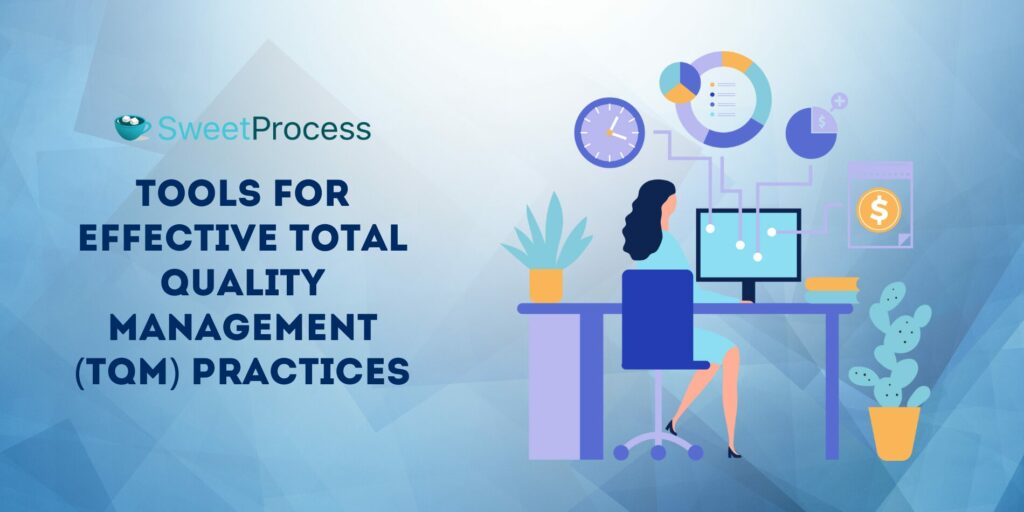
Pareto Principle
The Pareto principle identifies the vital few causes responsible for most quality problems. This tool, often visualized as a Pareto chart, identifies the 20% of factors causing 80% of the problems.
For example, if a manufacturer identifies that 80% of its defects come from 20% of its production lines, resources can be focused on those specific areas to make the biggest impact.
Scatter Plots
A scatter plot is a chart type that is normally used to observe and visually display the relationship between variables. A company might use scatter plots when examining the correlation between employee training hours and product defects to determine the effectiveness of their training programs.
Control Charts
Control charts track process performance over time to distinguish between normal variation and significant changes that require attention.
In food production, for example, control charts can track variations in temperature or ingredient measurements to ensure consistent product quality. These charts highlight when a process deviates from acceptable limits to enable immediate corrective actions.
Flow Charts
Flow charts visualize processes from start to finish, making it easier to spot inefficiencies and improvement opportunities.
For example, a software development company could use a flow chart to map out the bug-reporting process to ensure that every step—from identifying the issue to assigning it to the appropriate developer and deploying a fix—is well-coordinated and efficient.
Cause and Effect, Fishbone, Ishikawa Diagram
A fishbone diagram, also known as an Ishikawa diagram or a cause-and-effect diagram, is a visualization tool for categorizing the potential causes of a problem. This tool is used to identify a problem’s root causes. A logistics company, for example, can use a fishbone diagram to investigate delivery delays or uncover issues like driver shortages or poorly maintained vehicles.
Histogram or Bar Graph
Histograms visually display the distribution of data to help teams identify what is typical for their processes and spot unusual patterns.
For example, a call center can use a histogram or bar chart to analyze call durations. If they notice an unexpected spike in longer calls, it could prompt an investigation into potential causes, such as training gaps, system issues, complex customer inquiries, or inefficiencies in the process.
Check Lists
Control charts are essential tools for monitoring process stability and performance over time. They help teams determine whether a process is functioning as expected or requires intervention by distinguishing between common variations and unusual deviations.
For instance, in logistics, a control chart can be used to track delivery times to ensure that shipments are consistently on schedule and to identify delays that might require further investigation.
Check Sheets
Check sheets allow teams to collect and organize data systematically. In a quality control setting, employees can use a check sheet to record defects during a production run, which makes it much easier to analyze recurring issues.
Improve Your Company’s TQM Practices With SweetProcess

Total quality management fundamentally shifts how organizations think about and deliver value.
Bear in mind that:
- Quality isn’t a department—it’s everyone’s responsibility.
- Culture matters, but having the right tools matter more.
- Customer focus drives true quality.
The question isn’t whether your organization needs TQM—it’s how quickly you can implement it to gain a competitive advantage.
With SweetProcess, you can easily document, manage, and refine your workflows to support continuous quality improvement, ensuring every team member is aligned with your quality objectives. This approach helps your organization deliver consistent, high-quality results while fostering a culture of ongoing improvement.
Start your free 14-day free trial of SweetProcess today — no credit card is needed. Cancel anytime.
